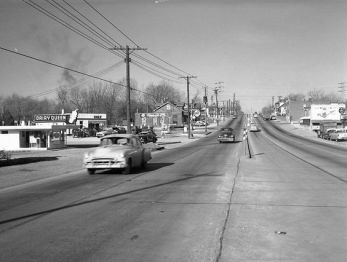In a part of St. Louis called St. John, an off-ramp from I-170 northbound curves north and west to meet St. Charles Road. This road, now the St. Charles Rock Road, had been a path for westward-heading wagon trains long before it carried Fords, Toyotas, and Mercedes.
 The Lewis and Clark Expedition had traveled through here in 1804 on what later became a post and stagecoach road. In 1851 it was paved with oak planks, later with gravel (and thus the reason “Rock” was added to its name), and in 1921 with concrete. Every workday, I travel it a short distance in addition to my I-170 and I-64 routes.
The Lewis and Clark Expedition had traveled through here in 1804 on what later became a post and stagecoach road. In 1851 it was paved with oak planks, later with gravel (and thus the reason “Rock” was added to its name), and in 1921 with concrete. Every workday, I travel it a short distance in addition to my I-170 and I-64 routes.
The north exit to St. Charles Rock Road arcs beneath I-170 to a stoplight. Between the arc of the ramp and the road sits a triangle of green, a mini-wetland environment where scrubby trees, cattails, wildflowers, and grasses grow. Some birds make their homes there: red-winged blackbirds, sparrows, cowbirds, barn swallows.
One particular spring evening stands out for me. I exited the freeway to make the curve to westbound St. Charles Rock Road, an orange and pink sunset glowing at its end. As I slowed to a stop at the light, I rolled my windows down. A cool breeze carrying the scent of bar-be-que wafted through, and from the green space came the “conk-a-ree” call of a red-winged blackbird and the trill of a song sparrow’s melody. I breathed in the breeze–and the sounds carried on it–and smiled.
The city’s rush boomed all around me too as semi-trucks’ engines throttled down, and a 747 roared into the sky, human-made machine noise masking the songs and chirps of the birds and the rustle of grasses in the breeze. Between the beats of someone’s music and the clunk of traffic crossing above, I heard the male red-winged blackbird proclaiming his ownership of the green space. I heard the song sparrow’s trill and the swallows’ calls to their hungry babies, no doubt peering out from their mud homes among the rusted, green girders of the overpass.
And I was reminded that the birds have been raising their young and the breeze has been carrying their songs for many centuries before I stopped here to listen. Grasses and wildflowers have whispered tales to one another in the wind long before this spot became a bustling intersection filled with human noise and traffic.
 This blackbird could be the far descendant of one who witnessed the quieter traffic of horse-drawn wagons heading west. That song sparrow’s ancestor might have trilled from a branch overlooking the streetcar line that once ran along this route. I was reminded in that moment that for the birds, the grasses, and the wildflowers, this is and has always been their home. We are just passing through.
This blackbird could be the far descendant of one who witnessed the quieter traffic of horse-drawn wagons heading west. That song sparrow’s ancestor might have trilled from a branch overlooking the streetcar line that once ran along this route. I was reminded in that moment that for the birds, the grasses, and the wildflowers, this is and has always been their home. We are just passing through.
As I looked around me at other people sitting in their cars waiting for the light to change, I wished they noticed these things too. I wish people could turn off their music, turn away from their cell phones, and roll their windows down to hear the music of ages past and the ages to come, the wisdom of place and time told by winged sages and the wind.

 illing is evidenced by wells and oil storage tanks. The countryside is a storage depot for railroad ties, earth-moving machinery, and cast-off scrap. Rusted-out cars from the 1920s and 30s sit in a ravine, their drivers and passengers long dead and buried in one of the graveyards situated on the barren hills.
illing is evidenced by wells and oil storage tanks. The countryside is a storage depot for railroad ties, earth-moving machinery, and cast-off scrap. Rusted-out cars from the 1920s and 30s sit in a ravine, their drivers and passengers long dead and buried in one of the graveyards situated on the barren hills.